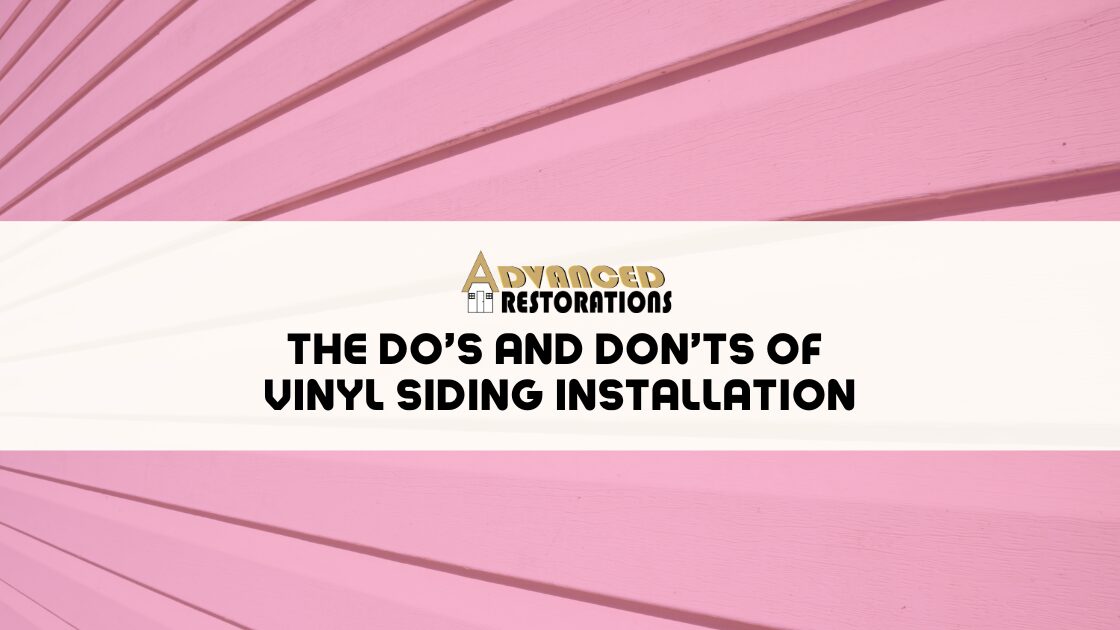
The Do’s and Don’ts of Vinyl Siding Installation
At Advanced Restorations, we’ve had the opportunity to see many vinyl siding projects during the time we’ve been in business. Sometimes we’re called upon to review work completed by another contractor, many times we’re attempting to replace a lone damaged wall for a property, and many times we’re called upon to replace siding for an entire house. Through that time and experience, we’ve seen just about every scenario – good and bad – one could expect to uncover.
Below, we’ve compiled a list of “Do’s” and “Don’ts” for theinstallation of vinyl siding, whether you have Advanced Restorations performing work for you or another contractor, be sure they’re keeping these issues in mind.
Do’s of Vinyl Siding Installation
- Follow manufacturer guidelines
- If the manufacturer of the vinyl product you’ve chosen to install has a specific instruction set, great! Be sure to follow their steps for installation. If not, they will more than likely dictate installation to be performed via the standards of the Vinyl Siding Institute – more than likely, the instructions are going to be very similar (outside of any unique scenarios you may see with a particular material).
- Install proper underlayment
- We’ve lost track of the number of properties we’ve seen where the wrong material has been installed – it’s not uncommon in our area to remove old vinyl siding and discover bare sheathing below. During installation, a vapor barrier of some sort needs to be installed – depending on your project needs, this may be as simple as house-wrap (think of this as synthetic felt for your walls) or it may be fanfold insulation. Whatever route is chosen, there needs to be something between the exterior sheathing of the walls and the vinyl siding – moisture can and will find a way behind the siding, that barrier protects the walls from further damage.
- Install proper trim materials
- Items like j-channel (or j-blocks) should be used around openings – doors, windows, etc. – this creates a proper channel (who could have guessed, given the name of the material) to rest in after installation. When removing old vinyl siding around openings that lack the proper trim pieces, nine times out of ten we will uncover sheathing below that is in some process of rotting due to moisture exposure.
- Finish trim or utility trim should be used to terminate siding when it ends at the top of the wall-line. It’s common in our area to see contractors simply ending in another run of j-channel, this typically leaves the wall hanging quite loosely and can lead to problems down the road.
- Allow material to move
- On nearly all vinyl siding materials you install, everything should not be nailed tightly to the existing wall sheathing. Vinyl is a material that can expand with heat and contract with cold, the product needs to be able to move as it encounters different weather conditions.
- Account for waste
- Per the Vinyl Siding Institute, when measuring a surface for installing vinyl siding, include smaller openings such as windows and service doors in your overall measurements. This will allow for the additional waste that comes into play when cutting material to install around those openings. If it is a larger opening in the wall, such as an overhead garage door, that surface should be subtracted from your total measurements.
Don’ts of Vinyl Siding Installation
- Mix manufacturers
- If at all possible, mixing different manufacturers of siding products should be avoided. Panel sizes, material finish, and color varies greatly by brand (and even varies depending upon manufacturing date). With updates to these products happening so often, mixing materials will not guarantee that the siding system will properly lock together – leaving you with issues down the road.
- Skip installing underlayment
- This point is worth repeating again – if a contractor wants to install vinyl siding without installing some form of underlayment, it may be worth reaching out to a new contractor. While the vinyl siding allows some protection from the elements, it is not designed to be the last line of defense. If your installation lacks the house wrap, you can be certain to deal with moisture damage to your home’s exterior sheathing somewhere down the line.
- Paint the siding
- Now, this can vary depending upon the manufacturer of the siding product in question but for many manufacturers, painting the product will void any future material warranties. Some homeowners may be tempted to apply paint as a cost-effective way to update their home but in the long run, they would be better served with having new siding installed. That will allow you to select a new look and leave you with capable warranties in the event the product has issues in its lifetime.
- Park your BBQ grill right against the side of the home
- While this isn’t directly related to installation, it is worthwhile to discuss. We’re sure plenty of people have dealt with this scenario, your grill is stored up against the rear of your home and during a particularly hefty grilling session, you had a large flare-up of flames. If that flare-up is large enough and long enough, you may have your grill close enough to the property to begin melting the siding closest to it.
These are some of the broader points in approaching the installation of vinyl siding to your home with many being very key elements to consider in your repairs – there are a lot of finer points we could cover but we’re trying to avoid publishing a full novel.
If you’re interested in installing new vinyl siding or you simply need an extra set of eyes to review a recently completed installation, call our office today at (417) 229-0667 and schedule an inspection with one of our knowledgeable Field Supervisors!
